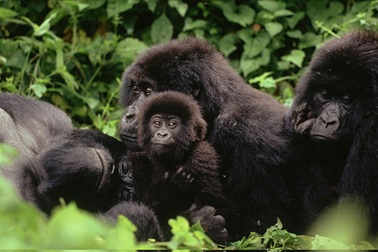Why in News ?
World Gorilla Day is celebrated every year on September 24. This day is dedicated to highlighting the importance of conserving gorillas and protecting their natural habitat.

History of World Gorilla Day
- On September 24, 1967, renowned biologist Dian Fossey established the Karisoke Research Center in the mountain forests of Rwanda.
- Dian Fossey dedicated her life to protecting mountain gorillas and conducted important research on their conservation.
- To commemorate her legacy and spread the message of conservation, the Dian Fossey Gorilla Fund declared September 24 as World Gorilla Day in 2017.
Objectives
- Raise awareness about gorillas' conservation
- Protect their habitat from poaching and deforestation
- Involve local communities and governments in conservation efforts
- Promote gorilla conservation through eco-tourism
- Pass on the message to future generations that gorillas are a precious part of Earth's biodiversity
Interesting Facts About Gorillas
- Gorillas are highly intelligent and powerful primates found in the tropical forests of Africa, sharing approximately 98% of their DNA with humans.
- Primates are an order of mammals that includes humans, apes, monkeys, langurs, gorillas, chimpanzees, orangutans, tarsiers, and lemurs.
- Gorillas are the largest primates on Earth.
- There are two main species:
- Eastern Gorilla
- Western Gorilla
- (Both of these also have subspecies, such as the Mountain Gorilla and the Cross River Gorilla)
- Gorillas are herbivores and primarily eat fruits, leaves, stems, and bamboo.
- Gorillas live in groups, called troops or bands. They are led by a dominant male, called a silverback.
- Gorillas are capable of displaying human emotions and intelligence; they can show sadness, happiness, and learning abilities.
Threats Facing Gorillas
- Deforestation – The rapid destruction of Africa's rainforests is destroying their habitat.
- Poaching – The bushmeat trade and poaching threaten the survival of gorillas.
- Diseases – Human-transmitted diseases (such as Ebola and COVID-19) are a major cause of gorillas' deaths.
- Climate change – Changes in weather and temperature affect their food and habitat.
- Human-wildlife conflict – Population growth is increasing encroachment on gorillas' habitats.
Conservation efforts
- Dian Fossey Gorilla Fund – The leading organization for the conservation and research of gorillas.
- UNESCO World Heritage Site – Many gorilla habitats in Africa, such as Virunga National Park, have been declared World Heritage Sites.
- Eco-tourism – Revenue is generated by allowing a limited number of tourists to view gorillas, which is then used for conservation.
- Involvement of local communities – Poaching is prevented by providing alternative employment to rural people.
- International agreements – Gorillas are listed in Appendix I of CITES (Convention on International Trade in Endangered Species), which prohibits their trade.
Gorillas and India
- Gorillas are not naturally found in India, as they live only in the forests of Central and East Africa. Nevertheless, many efforts are made to raise awareness about gorilla conservation in India.
- For example, wildlife conservation programs such as Project Tiger and Project Rhino inspire gorilla conservation principles and strategies.
- Additionally, zoos and wildlife parks in India organize educational and awareness programs to protect gorillas and spread information about them.
- Through these programs, people are informed about gorillas and the importance of their conservation.
|
Q. On which date is World Gorilla Day celebrated every year ?
(a) April 22
(b) September 24
(c) August 15
(d) June 5
|



